Chit-chat with the sculptor – Subrata Paul
(Reading Time: 15 min Approx)
It was busier than usual at Rabindrasadan that evening owing to the preparations for the Kolkata Film Festival at Nandan. We snaked our way towards the Academy of Fine Arts where an interview was scheduled with sculptor Subrata Paul (SP). At sharp 6 p.m he walked into the portico of the gallery of the Academy. Despite being the member of ‘Calcutta Sculptors’ (founded in 1993) he carried an air of humility and compassion, very unlike the usual superior airs of accomplished artists and sculptors. We settled at the stairs, just like the common art enthusiasts do, outside the gallery among all the humdrum of the ongoing exhibition. There was no unnecessary chitchat or the social formalities and we came straight to the interview part. His pleasant demeanor made it very comfortable for me to conduct my first interview.
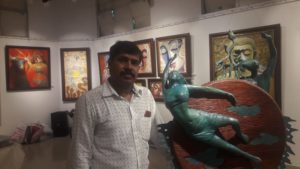
How did your life as a sculptor start?
SP: (With a slight smile brought on by the memories of childhood) Well, when I was quite young, no more than 7 or 8 years, while my mother made rotis, I would play with the dough of atta. I made miniature dolls, structures with the dough. Later when plasticine came into the market, I tried my hand at plasticine sculptures. My family, especially my late mother Mrs. Dipti Paul encouraged me to take sculpting seriously. I studied art and received my diploma in Fine Arts, from the Academy of Fine Arts at Kolkata in 1998. My mentors urged me to pursue sculpting more so because, apart from my interest in it, my house was near where sculptor Samir Kumar Das stayed and that I would get a sound guidance from him. In a few years I realized that sculpture had been the perfect choice for me as I was able to depict my artistic thought and exercise my creative liberty best while sculpting.
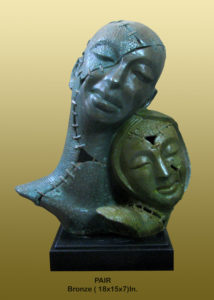
Sculpture has its own myriad pleasures. Since the art is in 3D form, it becomes tangible and much more easily comprehensible. I am able to feel and study my artworks closely. Though it is much easier to depict sense of direction and movement in paintings, but they are quite difficult to place in a sculpture. Sculpture requires a much more minimalistic sense of displaying emotions and actions. Each artist always looks for his/her individual style which matches no one else’s.
Tell us a bit about your process of sculpting. Do you draw a draft of the artwork before? What kind of materials do you use?
SP: At first, I draw a simple line drawing of my sculpture. Then I make a miniature model of the figure I am about to make. At this stage, new ideas crop up in my head, I include and exclude certain things. After which I move on to the final stage which is sculpting the actual artwork.

Recently I have adopted a mixed media method of sculpting with wood, bronze and zinc. In my workshop I have my assistants who melt, cast the metal, and beat it into the proper shape. Once the basic structure is ready, I and my helpers put together the complete sculpture, adding, editing bits and pieces here and there. Secondly, the sculpture is painted. The final finishing work is done by me alone.
Almost all your artworks possess a flow of life, as if they were frozen while they were still moving. How did you develop this unique elongated style?

SP: Yes! you’re quite right. Some sculptors like working with a lot of volume, some like a vertical progression in their sculptures. I happen to love this elongation, a flow in sculptures. I can infuse a sense of life and movement into them through this style. Due to this feature, my sculptures look very rhythmic and the softness is evident in the human figures which is my intention. I always want that the viewers of my art can feel the passion, beauty, harmony and love for life that exists between the mankind and nature.
Recently I have introduced a new feature in my sculptures i.e. the mark of stitches between the layers of the metal. These stitches, as once art historian Prasanta Daw had written ‘break the uniformity of the sculpture surface, bears a sensitive aesthetic sense.’ These stitches depict the bonding and connection in any relationship, be it mother and child, or human and an animal or lovers.
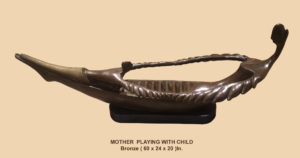
Have you gone through a phase of creative block that is quite common among artists and writers?
SP: Yes, I can understand what you’re talking about; becoming metaphorically blind is a common issue among artists after a period.

The thing is all artists are looking to come up with their unique form of art, their own language. Earlier whatever I made or attempted to make, I felt that this piece of art has been created before. This is a very common thing. You may create something that is quite similar to some other artist’s work despite the fact that you have never met him or seen his artworks. The secret is to push past these fears and keep creating. As a sculptor, I am always thinking of new compositions. Anything, from walking on the street or sitting at an auditorium can light a spark in your creative mind, only if you keep the windows and doors of your mind open. We artists are always observing daily life, simple activities, human beings we meet or see throughout the day. Among those whenever a form catches my attention, I go home and make a draft of it modifying and juxtaposing it with my imaginations. So the observation, imagining and composing within my mind never stops which is the key to go on creating as an artist.
Did your parents support your decision to become a sculptor?
SP: Yes, I am very lucky in that area. My family was quite supportive of my art education and my career as a sculptor.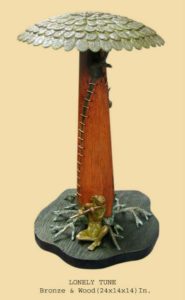
This is the first hindrance young artists face unfortunately at the brink of embarking on their creative journey. But I would say to parents and hesitating youngsters that a career in Fine Arts is a very prospective one and more and more people are taking up this path as their vocation. Not only for financial reasons but also there is a joy in creating art and giving life to your imaginations.
Who do you see as your inspiration?
SP: Well, at the beginning of my life my mother was a big inspiration to me as she urged me to learn experiment and create sculptures.
During my years at the Academy of Fine Arts in 1996 or 1997, I once went to an exhibition by the artist Chintamani Kar. I had never witnessed artworks with such extensive volume, depth and magnificent features as depicted in his sculptures. It was a significant point in my life. I was very influenced by the wholesomeness and magnanimity in works and decided to reach that height of skill one day. Now my sculpting is free from outside influences. I have developed my unique form. But yes, Chintamani Kar’s artworks moved me to my core and stirred my fascination with sculptures.

What, according to you, is the element missing most in current Bengal art community?
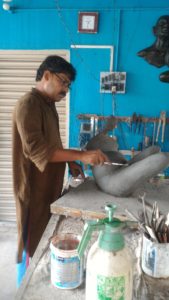
SP: Look, artists of Bengal are creating excellent work. In the age of internet, the world has become smaller and the art world of Bengal is very promising and is flourishing every single day. The element that is missing is the appreciation of those artworks. Regardless of their background, talented artists should be appreciated and should be given their due share of accolades. But sadly, that is not the current scenario.
What do you think an aspiring sculptor should do in order to make it in the artist community of Kolkata? What would be your message to them?
SP: Hard work, dedication and devotion. There is no alternative to these three things. Young sculptors have to keep thinking, imagining, drawing, creating, working and experimenting each and every day. Their inner creative mind should never be idle, and they should never succumb to shortcuts which only bring momentary glory which never lasts.
Our discussion about art and sculptures and the perils of a freelance career went on for about another ten or fifteen minutes. It was the most interesting and satisfying conversation with an artist so far as Mr. Subrata Paul held an unassuming air and carried a kindhearted personality which encouraged my inquisitions. His ethereal sculptures are a must see. I can guarantee that people of all generations will find themselves enamored once they witness his artworks face to face.


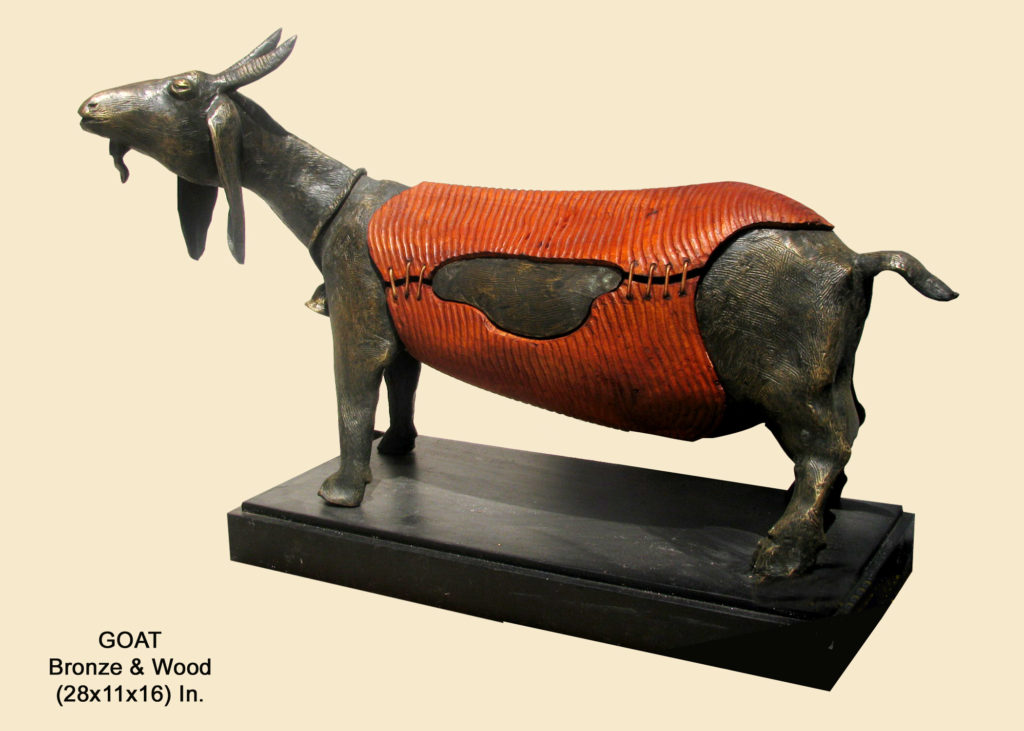
One thought on “The man with magic in his fingers”